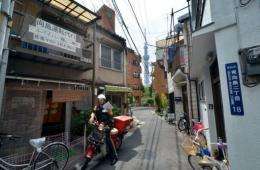Tokyo prepares for the 'Big One'

Seen from atop the towering Tokyo Sky Tree, the patchwork of narrow alleyways and ramshackle houses that make up Tokyo's Sumida district is a picturesque throwback to the Japan of yesteryear.
But this densely packed district—home to about 230,000 people—is one of the Japanese capital's most at-risk neighbourhoods, where officials are busily preparing for the "Big One", a long-expected monster earthquake that experts say will one day rock the city of 12 million.
"The earthquake will happen," said Shinishi Sakai, a professor at the University of Tokyo's quake research institute.
"We don't know when, but it definitely will happen."
Seismically-active Japan is used to quakes and the threat of tsunami. It has been on heightened watch since the March 2011 disaster, which pounded the nation's northeastern coast, leaving around 19,000 dead or missing.
While the epicentre was well away from Tokyo, the 9.0 magnitude quake sent powerful tremors through the huge city, a salutary reminder to residents young and old that they are living in a potential disaster area.
"Many people were crying—of course I was afraid," 10-year-old Tokyo student Shuntaro Kanuka remembers.
Experts have long warned that Tokyo—Japan's financial, political, economic and social capital—is vulnerable to a massive temblor that will rival the 1923 Great Kanto Earthquake, which killed more than 100,000 in and around the sprawling megalopolis.
And few in Sumida doubt the destruction that could be unleashed by such a disaster—the district was destroyed during Tokyo's worst quake as fires ripped through its maze of low-lying wooden homes.
While much of Tokyo's modern architecture is quake-resistant, the same cannot be said for Sumida with its wood-framed homes and narrow streets that would be nearly impossible for emergency crews to navigate.
To deal with that problem, residents regularly participate in fire drills in the shadow of the newly constructed Tokyo Sky Tree—the world's tallest tower at 634 metres (2,080 feet).
The communications tower would play a key role in any future disaster with mobile cameras that monitor the area and could help ease a large-scale evacuation, says Koji Sudo, head of Sumida's disaster-prevention unit.
"A fire would be immediately detected by the cameras, so it makes evacuation easier and people can be guided to safe zones," he said.
Inside the tower is a satellite-linked observation centre connected to emergency services. Outside, tanks are filled with thousands of tons of water to help quell any blaze.
"We have an autonomous power supply that will last three days and our own radio and phone transmission system," Sudo said.
Concern about the so-called "Big One" spiked again over the summer when the government unveiled a worst-case disaster scenario that estimated 323,000 people would die if a 9.0 magnitude unleashed a 34-metre tsunami along the coastline south of Tokyo.
City officials said it was intended to encourage improvements in quake warning systems, evacuation planning and disaster reduction.
It coincided with a national earthquake drill, held every year on September 1.
Police suspended traffic at some 120 points in central Tokyo to dedicate lanes to emergency and military vehicles while passengers were guided to safe zones from train stations in a simulation of a post-quake scenario.
About 8.0 billion yen ($100 million) has been spent on fireproofing homes in Sumida, especially the wooden-framed residences, and clearing dead-end streets that would prevent residents from fleeing.
"People want to live and work here. This is why we are working to make the area more resistant to earthquakes and fires," said Shigemoto Sahara, head of a local residents' association.
Sahara added that the association has ramped up efforts to keep track of its residents, especially the elderly.
"After March 11, we made a list of old people in the district, especially those living alone. There is a sense of solidarity here," Sahara said.
As Japan become better prepared for the inevitable disaster, new knowledge also brings new uncertainty.
In the past five years, nearly 300 seismographs have been installed in Tokyo schools at a cost of over 1.0 billion yen, transmitting data to a central authority.
But the plan has also revealed worrying subterranean activity: fault lines far shallower than previously thought.
"It was a great shock to me," said Sakai at Tokyo's quake research institute, as he stared as his seismograph-connected laptop.
"It's constantly moving down there."
(c) 2012 AFP




















